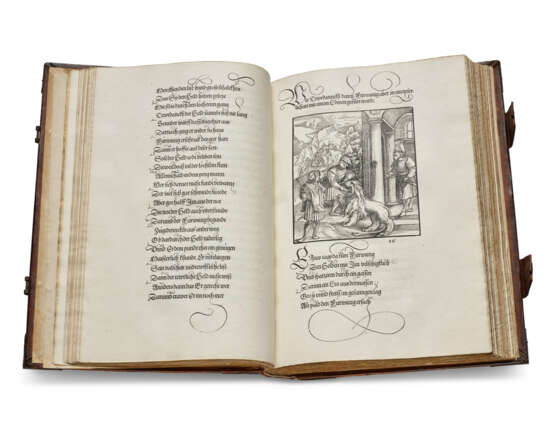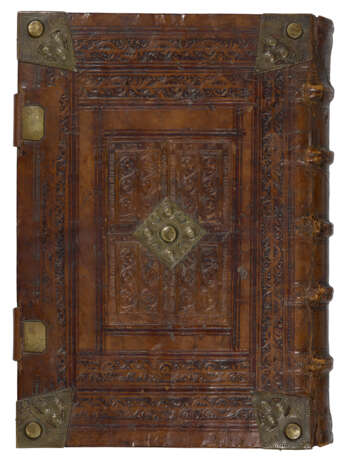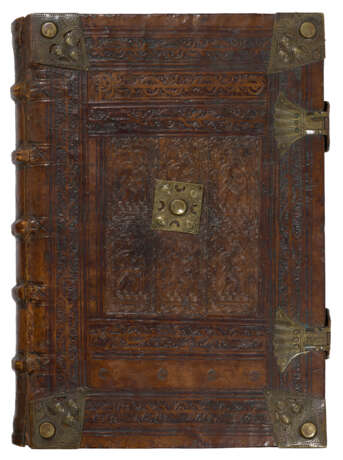ID 1105590
Lot 74 | PFINTZING, Melchior (1481-1535)
Estimate value
£ 40 000 – 60 000
[Theuerdank]. Die geuerlicheiten und einsteils der geschichten des loblichen streytparen und hochberümbten helds und Ritters herr Tewrdannckhs. Nuremberg: Johann Schönsperger the elder for the emperor Maximilian I, [1517].
First edition of one of the finest illustrated books of the German Renaissance; a tall copy retaining its many fine flourishes. Theuerdank is a chivalric poem celebrating the reign of Emperor Maximilian, who appears as the eponymous hero, and follows him as he performs feats and overcomes obstacles along a journey to win Mary of Burgundy (Kunigin Ernreich) as his bride. It forms part of a trilogy, with Weisskunig and Freydal, but was the only one of the three to be published during Maximilian's lifetime. The edition was intended uniquely for presentation by the Emperor, but his death only 2 years later meant that the majority were distributed by Archduke Ferdinand, through Marx Treitzsauerwein, as memorials to the late Emperor.
Maximilian himself was closely involved in all aspects of its lavish production, from its composition to its distribution after printing. He had written first drafts in 1505-1508 and turned over the completion and general editing of the work to Melchior Pfintzing, his private secretary. Maximilian called Schönsperger from Augsburg to Nuremberg to print the work in the imperial city (the only work Schönsperger printed there); a remarkable series of woodcut illustrations – among the finest of the German Renaissance – were cut, commissioned from some of the greatest woodcut artists of the day, Schäufelein, Beck and Burgkmair; and a calligraphic type was specially cast to print it. The design of the type is traditionally attributed to Vinzenz Rockner, Maximilan's court secretary, but seems to derive from the writing books of Leonhard Wagner of Augsburg. It is one of the earliest Fraktur types, which was quickly adopted as a national typographic style which lasted for centuries. Its success was undoubtedly due to the Emperor's patronage (Peter van Wingen, in Vision of a Collector, the Lessing J. Rosenwald Collection in the Library of Congress, Washington 1991, 9, p. 31; A.F. Johnson, 'Printing in the Sixteenth Century', The Dolphin, 1938, pp.131-2). The series of woodblocks were cut by the best-known artists of the day under the direction of Jost Negker, a Flemish type designer and engraver who worked for Schönsperger. They were reused for a second edition in 1519 and some continued in use until the end of the 17th century. Adams P-962; Brunet V, 787; Davies, Fairfax Murray, German 329; Hollstein V: 416-430 (Burgkmair); Illustrated Bartsch 11: 132, 1-8 (Schaüfelein); Muther 845.
Royal folio (355 x 248mm). 290, complete with blank P5 and postliminary quire A8. Gothic (fraktur) type, with all flourishes intact, xylographic title and 118 numbered woodcuts by Jost de Negker and Heinrich Kupferworm after Leonhard Beck (77), Hans Burgkmair (13), Hans Schäufelein (20), and others, without printed correction slips found in the vellum copies (expertly repaired tear in about 3 leaves). Contemporary German blindtooled calf over unbevelled wooden boards (EBDB workshop W007523), sides panelled with Laubstab rolls and filets, upper cover with a pilgrim panel repeated 6 times, lower cover with an animal panel with text ‘deus det nobis…’ repeated 4 times on lower cover, possibly later metalwork, edges gilt and gauffered (resewn and rebacked retaining most of early backstrip, clasps renewed, discreet repairs at edges, possibly a remboitage, some minor scuffing); modern brown morocco-backed folding box tooled ‘BPH’ on front cover. Provenance: Ochsenhausen, Benedictine monastery of St. George (stamp on title) ‒ J.R. Ritman, Bibliotheca Philosophica Hermetica, Amsterdam (bookplate, initials on box).
| Address of auction |
CHRISTIE'S 8 King Street, St. James's SW1Y 6QT London United Kingdom | ||||
|---|---|---|---|---|---|
| Preview |
| ||||
| Phone | +44 (0)20 7839 9060 | ||||
| Buyer Premium | see on Website | ||||
| Conditions of purchase | Conditions of purchase |







